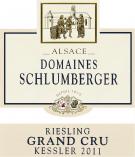History
Mentioned as early as the year 1394, the Kessler has been marketed under its own name since 1830.
Location
The Kessler grows on a sandstone soil and displays in its centre a valley that is globally facing east, south-east, which protects it from north winds and cold air streams brought by the valley of Guebwiller. As a natural extension of the Grand Cru Kitterlé; its subsoils are reddish over Vosgean sandstone bedrock. At its base, an outcrop of limestone results in clay soils.
Wine-making
Whole grape pressing, static racking. Fermentation in thermocontrolled tuns for 1 to 4 months. Ageing on fine lees for 8 months.
Gastronomy
I recommend enjoying this with ginger flavoured lobster casserole, soft cheeses and washed rind cheeses such as the Epoisses. Serve at a temperature of 12°C.
Technical sheet by Pascal Leonetti
“Best Sommelier of France 2006”
Learn more about food & wine pairingTasting
The robe is golden yellow with clear reflections, of great intensity. The disk is bright, limpid and transparent. The wine shows a slight growth.
The nose is frank and pleasant with a good intensity. Complex, one perceives dominant over ripened smells of fruits, honey, beeswax and balsamic. Airing remains “atypical”. One smells, although very lightly, fine fruity and citrus notes reminiscent of the riesling.
The nose is original and atypical. The range of fragrances is more earthy.
THe onset in the mouth is rich and soft. The alcohol support is full-bodied. The wine evolves on a frank, incisive medium, which cools well on maturity. The range of aromas turns around honey, milk toffee, candied citrus, lemon, basamic, sweet spices as well as a fine lactic touch. The finish has a good length, 7-8 caudalies, and is subtly vivacious.
The balance of this wine is soft and well-built. With an “atypical” opening, the onset in the mouth shows the profile of an over-mature riesling.

















